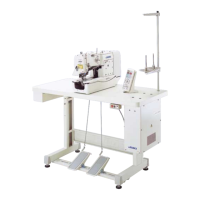
Do you have a question about the JUKI LBH-1700 and is the answer not in the manual?
| Stitch Type | Lockstitch |
|---|---|
| Needle Type | DB x 1 |
| Motor | Servo Motor |
| Weight | 45 kg |
| Lubrication | Automatic |
| Type | Lockstitch |
| Buttonhole Length | Adjustable |
Adjusting needle bar height at lowest dead point for proper clearance.
Aligning needle and hook for correct stitch formation and timing.
Adjusting clearance and smooth operation of stitch width gears and PM arm.
Setting origin sensor for centered needle detection.
Setting origin sensor for centered needle at zero stitch width.
Setting presser and feed shaft distance from needle hole and end faces.
Ensuring the cloth cutting knife drops correctly into the center groove.
Setting clearance between trimmer control lever and arm when safety hook engages.
Adjusting the longitudinal movement of the needle thread trimmer arm.
Aligning trimmer with needle and setting lateral protrusion.
Installing trimmer low, avoiding contact with the presser.
Adjusting trimmer opening timing for gradual opening.
Adjusting trimmer opening amount, timing, and bobbin winder trip latch.
Calibrating feed, stitch base line, and stitch width motor origins.
Guide for sensor input checks and troubleshooting using the test mode.
Troubleshooting sewing issues like needle thread breakage and stitch skipping.
Troubleshooting mechanical problems like cloth cutting knife failures.
Diagnosing and resolving issues with electrical components and errors.
